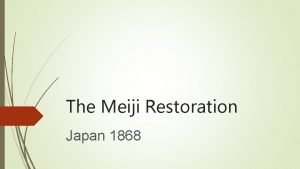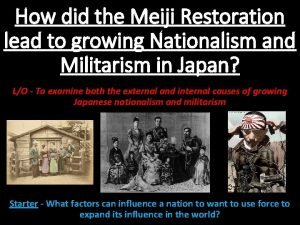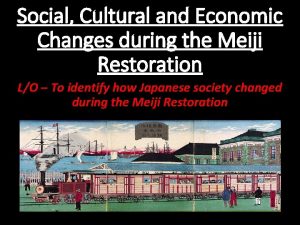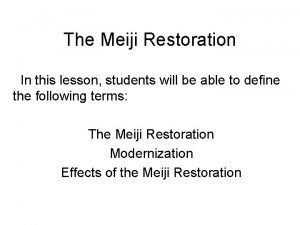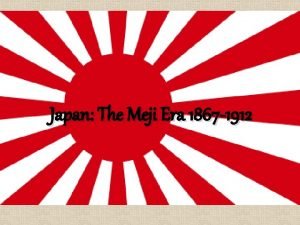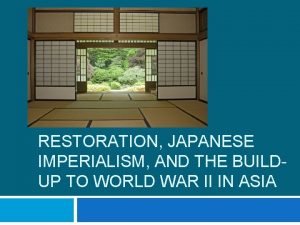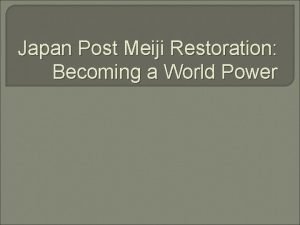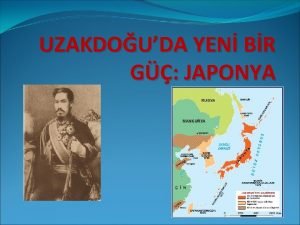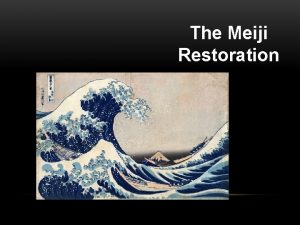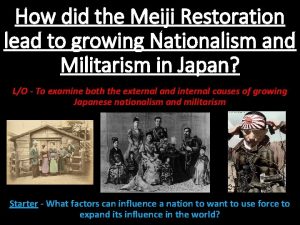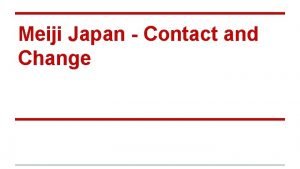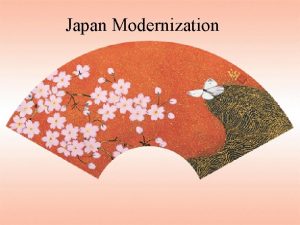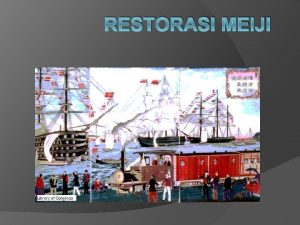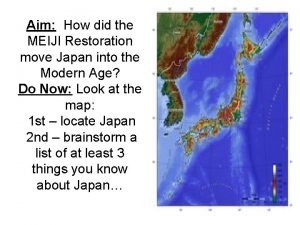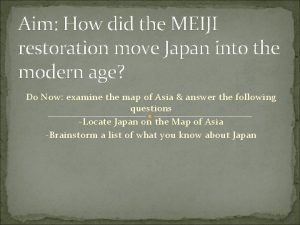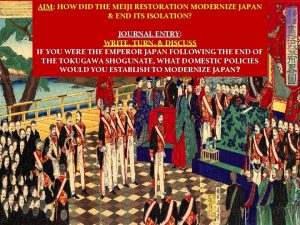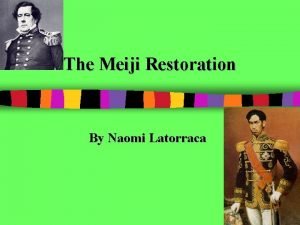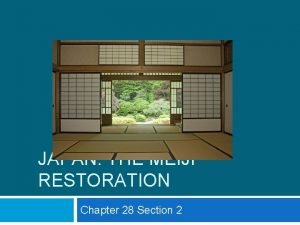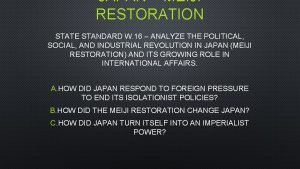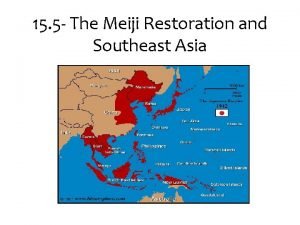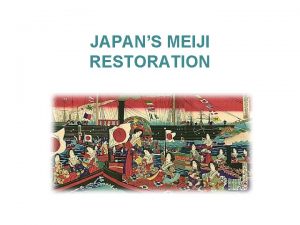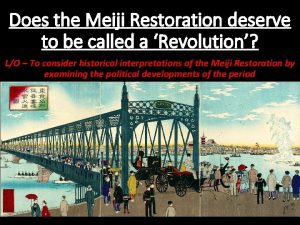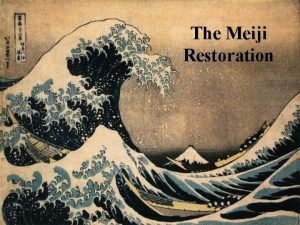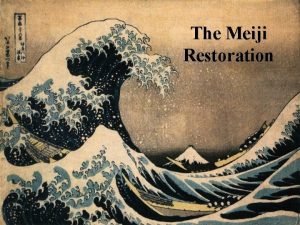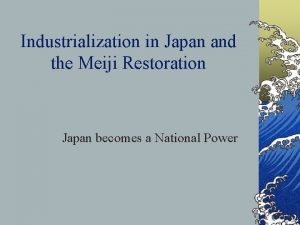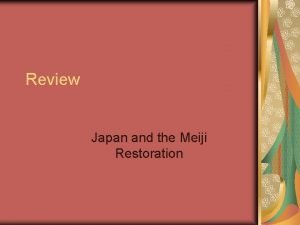How did the Meiji Restoration lead to growing













































- Slides: 45

How did the Meiji Restoration lead to growing Nationalism and Militarism in Japan? L/O - To examine both the external and internal causes of growing Japanese nationalism and militarism Starter - What factors can influence a nation to want to use force to expand its influence in the world?

Japan’s Road to War • During the 1930 s, Japan expanded its territory into Manchuria, withdrew from the League of Nations, invaded China, signed a military alliance with Fascist Italy and Nazi Germany, and attacked the USA at Pearl Harbour in 1941. • How did Japan come to pursue such an aggressive and militaristic foreign policy? • Was it an inevitable part of Japanese politics and culture? Was it due to economic necessity? Or was it the fault of the Western nations?

The Roots of Japanese Nationalism • Some historians consider the long-term social and cultural values that ‘determine’ that certain events happen in history. • ‘Determinist’ historians believe that the roots of Japanese ultra nationalism grew from the Meiji Restoration of 1868. • Believing its survival to be under threat, Japan opened its doors to Western influences, abandoned its military ‘shogunate’ government, and elevated the Emperor to a position of authority with god-like status.

The Roots of Japanese Nationalism • Japan sought to radically transform itself from a traditional Confucian feudal society to a strong and modern nation-state based on the Western model. • Changes were sought to not only defend Japan from Western imperialism, but to compete with and outdo the USA and European nations. • To accomplish this, Japan needed a prosperous industrial economy to fund and equip a strong military.

The Roots of Japanese Nationalism • Japanese leaders also realised that the key to Western power stemmed from a well educated population that embraced a strong sense of nationalism. Japanese culture was therefore modernised and Westernised in imitation of the West. • Between 1868 and 1930, Japan achieved its aims: fighting and winning the Sino-Japanese War (1894 -95), the Russo-Japanese War (1904 -05), forming an alliance with Britain in 1902, and joining the Allies in WW 1.

1894 -5 – Sino-Japanese War, Japan gains Taiwan and Korea becomes a Japanese protectorate

1904 -5 – Russo-Japanese War, Japan beats Russia. First Asian country to beat European nation!

Japan before the Meiji Restoration • Before 1868, Japan was in theory ruled by the Emperor, but in reality was ruled by a military government known as the shogunate or bakufu. • Since 1603, the Tokugawa had been the dominant clan of military leaders. It leaders was called the ‘Shogun’. • Beneath the Shogun were the feudal lords called ‘Daimyo’. They ruled over provinces of land with the help of the ‘Samurai’ class who kept order and swore loyalty to their daimyo. Emperor Shogun Daimyo Samurai

Map showing the different provinces of Japan before unification by Tokugawa Ieyasu

1600 A. D. - The Battle of Sekigahara


Japan before the Meiji Restoration • Four nearly 400 years the Shogunate had ruled Japan, isolating itself from the world. But by the 1800 s, the strict hierarchical order of society was breaking down. • ‘Structuralist’ historians examine the structure of society as a way to explain change, such as its economy or social class system. • Many structuralists argue that economic changes within Japan, like the growing wealth of the middle/merchant class, led to tensions that ultimately brought about the Meiji Restoration.

Japan before the Meiji Restoration • Population growth in society had increased the demand for food. This made the inferior merchant class wealthier than the Samurai. • At the same time, the obligations on the Samurai to attend the imperial court at Edo led them into debt, increasing the anger of the Samurai with the status quo. • Ambitious regional rivals like the Satsuma and Chōshū clans from Kyushu therefore saw an opportunity to seize power.

What triggered the Meiji Restoration? • By the 1850 s, tensions in society had reached such a point that some Daimyo sought to remove the Shogun from power and create a new society. • It’s at this point that the US Navy sailed into Edo harbour on 8 th July 1853, demanding that Japan opened its borders for trade. • Led by Commodore Matthew Perry, the ‘four black ships’, which increased to eight the following year, humiliated the Shogun into opening Japan for trade.


What does the source convey about how the Americans were perceived at this time in Japan?

What triggered the Meiji Restoration? • By 1858, Japan had signed the Treaty of Kanagawa with the USA, allowing the US to dominate trade. • It seemed as if Japan would go the way of China which had just lost the Opium Wars to Britain. • The level of anger and mistrust of the Shogunate rose in Japan as its rivals blamed the Shogun for appearing weak against the US, triggering the rebellion that became know as the Meiji Restoration.

1842 – British victory over China in Opium War worries Japan: could it happen to them?

How did the Shogunate collapse? • ‘Intentionalist’ historians believe that individuals are the ones that shape history, not ‘economic forces’ or cultural influences. People have ‘agency’. • This can be seen in the leadership skills of the Satsuma and Chōshū clans, who despite lacking power – joined forces, modernised their army, and marched on Edo. They called for ‘Sonno Joi’ – revere the Emperor, repel the barbarians! • By 1867 the Shogun had ceded power to these clans. After a brief civil war between 1868 -69, the bakufu was finally defeated and the ‘restoration’ of the Emperor announced.


Problems facing the new State Social Problems Japan was divided socially by a rigid class/caste system known as the shi-no-ko-sho. Japan was a fixed, hereditary system. No incentive for people to improve their lives, reform or innovate. Cultural Problems Confucian belief system under In 1868 Japan had an advanced the Tokugawa Bakufu feudal economy but was still discouraged change to the social based on agriculture. Silk was its system and Westernisation. main export. Elements of society hostile to Westernisation and development. Samurai stipends amounted to Samurai culture and ‘Bushido’ 50% of government expenditure discouraged many Samurai from in 1871. adapting to modern warfare. No public school system in 1868. Women had no rights in society. Economic Problems Japanese national identity was still weak and many not committed to the emperor as a political symbol. No national tax system in 1868! Lack of government funds for development and industrialisation. Japanese industry faced foreign competition on unequal terms, unable to protect its own industries. Japan lacked raw materials for industrialisation.

How did the Restoration change Japan? • With the restoration of Emperor Meiji (Mutsuhito), Japan experienced both modernisation and a return to traditional belief. • A personality cult was formed around the Emperor, who, according to the now official Shinto belief, was the descendent of the Sun Goddess Amaterasu. • Thus the new Japanese state intertwined religion, emperor worship, and nationalism - Love of the Japanese nation was bound up with loyalty to the Emperor as the ‘embodiment’ of the nation.

Political Changes to Japan • The new Meiji state ushered in huge political change. In April 1868 the Emperor issued the ‘Charter Oath’ which promised: the creation of democratic assemblies; an end to the feudal class system; and modernisation of the country. Ito Hirobumi • For the next 20 years the nation was ruled by the Emperor but real power lay with the ‘Genrō’ – a group of advisors who had organised the Restoration. • In 1889 they finally published a Constitution which was ‘gifted’ to the Japanese people by the Emperor. “Fukoku kyo nei!” (rich country, strong army)



Political Changes to Japan • The Constitution was based on the German political system. A bicameral parliamentary system known as the ‘National Diet’ was created, made up of the House of Peers and the House of Representatives. • All men over 25 who paid a certain amount of tax (1. 14% of population) could vote for members of the House of Representatives. • The House of Peers was made up of the nobility, senior civil servants, high-ranking military officers – all appointed by Emperor. “Popular sovereignty would be a very dangerous thing…”

This source is a print of the Imperial Diet in 1890. What impression does this convey of the kind of body that governed Japan at this time?

Political Changes to Japan • The purpose of the Diet was to assist the Emperor in decision-making, NOT to act as the main seat of power. The Emperor could still issue his own Imperial edicts and veto any legislation. • The military was made directly responsible to the Emperor, not the parliament. • Despite having ultimate power, the Emperor was not expected to make political decisions. Instead, the Genrō would ‘advise’ the Emperor on what to do.

When created, the cartoon in Source A would have been aimed at a European audience. What kind of image of the Japanese Emperor do you think it was trying to convey?


Social Changes to Japan • Firstly, it ended traditional ‘shi-no-ko-sho’ class distinctions. The Daimyo and Samurai lost their position in society and everyone was made equal and able to be conscripted into the new Imperial Army and Navy. • Secondly, nationwide elementary schooling was introduced in 1872 in order to produce workers and soldiers capable of using new technology. By 1905, 98% of children went to school for at least 4 years. • The 1890 Imperial Rescript on Education had to be memorised and recited every morning, further indoctrinating the people for military sacrifice. Samuari - shi Farmers - no Artisans - ko Merchants sho



Military Changes to Japan • In the feudal system, the Samurai as the professional military class owed allegiance to their Daimyo only. In the new Meiji state, conscription was introduced in 1873 and all men swore loyalty to the Emperor. • All Japanese men had to serve 3 years, which instilled a sense of national unity in men. • The 1882 Imperial Rescript for Soldiers and Sailors further enforced absolute loyalty amongst men – they were banned from having political views, even in private! “…the 1882 imperial decree could be considered one the latent underlying causes of Japan’s militarisation of the 1930 s and, eventually, its attack on Pearl Harbour. ” Eri Hotta, Japan 1941, 2014, p. 79

Cultural Changes to Japan • As Westernisation increased, all things ‘Western’ became synonymous with progress and civilisation – to be modern was to be Western. • This could be seen in fashion, education, culture, and the arts. The publishing industry drove these ideas, with books, magazines, newspapers, and novels all discussing Western ideas. • By 1872, Western style dress had become obligatory at the Royal Court. Yet Japan sought to also revive and fuse Western ideas with Japanese traditions. Shinto and Bushido were promoted as part of being ‘Japanese’.

Economic Changes – Emperor Worship • Ever since the Iwakura Mission in 1872, the reformers realised that the source of Western strength came from their economic power: ‘Our recent travels have taken us to many interesting and famous places…there is nothing we have not visited. Everywhere you go there is nothing growing in the ground, just coal and iron… Factories have increased to an unheard-of extent, their black smoke rising to the sky… This is a sufficient explanation of England’s wealth and strength… and it is said that this great growth of trade and industry in the cities is something which has happened in the last fifty years. ’ Okubo Toshimichi, 20 th December 1872, four days after leaving Dover, UK. Okubo was deputy to the ambassador Iwakura Tomomi and was himself an ex -samurai.

Economic Changes – Financing Growth • The first problem was financing the government budget. In 1871, the government took on the debt of all the domains. Samurai costs reached 50% of total government expenditure. • By dismantling the privileges of the Daimyo and Samurai class, the government reduced costs. • 1873 – A National Land Tax was introduced for the first time, demanding cash payments instead of rice.

Economic Changes – Industrialisation • The government next used these funds to build new industries and ‘model factories’ for the business community to imitate. • Shipping lines, railways, telegraph and telephone systems, shipyards, mines, munition works and consumer industries like sugar, glass and cement were built. • However by the 1880 s, a lack of funds forced the government to sell these industries to private businesses. In return for working for the government, the companies would get special privileges.

Economic Changes – Industrialisation • This became known as the Zaibatsu system (huge business conglomerates) like Mitsubishi and Nintendo were created at this time. • Many Zaibatsu found it hard at first to compete internationally, so many companies sold their products at a loss to gain markets. • The Japanese Silk industry was one market in which they dominated, helped by the failure of the Italian Silk Market.


Raw Silk Production & Export from Japan 1868 -1913 Period Production annual average (tons) Exports annual average (tons) 1868 -1872 1026 646 1883 1687 1347 1889 -1893 4098 2444 1899 -1903 7103 4098 1909 -1913 12460 9462

Coal Production in Japan from 18751913 Period Coal Production (metric tons) 1875 600, 000 1885 1, 200, 000 1895 5, 000 1905 13, 000 1913 21, 300, 000

The Size of the Japanese Merchant Fleet from 1873 -1913 Period Number of Steamships 1873 26 1894 169 1904 797 1913 1514

Road Mileage in Japan from 1873 -1913 Period Track (miles) 1872 18 1883 240 1887 640 1894 2100 1904 4700 1914 7100

Plenary 1. What were the four divisions of society before the Meiji restoration? 2. Which two domains led a rebellion against Tokugawa Yoshinobu and when was this? 3. Describe at least two points from the Charter Oath 4. What changes did the 1889 Constitution introduce? 5. Why was the Meiji Restoration such as significant change? 6. In what ways was the authority of the Emperor enforced and conveyed to the people of Japan? 7. How did the Meiji Restoration increase nationalism and militarism in Japan? Did we meet our learning objective? L/O - To examine both the external and internal causes of growing Japanese nationalism and militarism
 Meiji restoration
Meiji restoration Japan before meiji restoration
Japan before meiji restoration 5 element of national identity
5 element of national identity Meiji restoration definition
Meiji restoration definition Emperor shogun daimyo samurai peasants
Emperor shogun daimyo samurai peasants Define meiji restoration
Define meiji restoration Meiji restoration
Meiji restoration Lead magnesium niobate/lead titanate
Lead magnesium niobate/lead titanate 3 contoh slogan tentera jepun
3 contoh slogan tentera jepun Meiji restorasyonu ile japonya'da yapılan yenilikler
Meiji restorasyonu ile japonya'da yapılan yenilikler Latar belakang munculnya otonomi daerah
Latar belakang munculnya otonomi daerah Meiji university ikuta campus
Meiji university ikuta campus How did the assassination lead to war
How did the assassination lead to war Chúa yêu trần thế
Chúa yêu trần thế Sự nuôi và dạy con của hổ
Sự nuôi và dạy con của hổ đại từ thay thế
đại từ thay thế Vẽ hình chiếu vuông góc của vật thể sau
Vẽ hình chiếu vuông góc của vật thể sau Công của trọng lực
Công của trọng lực Tỉ lệ cơ thể trẻ em
Tỉ lệ cơ thể trẻ em Thế nào là mạng điện lắp đặt kiểu nổi
Thế nào là mạng điện lắp đặt kiểu nổi Các loại đột biến cấu trúc nhiễm sắc thể
Các loại đột biến cấu trúc nhiễm sắc thể Lời thề hippocrates
Lời thề hippocrates Vẽ hình chiếu đứng bằng cạnh của vật thể
Vẽ hình chiếu đứng bằng cạnh của vật thể độ dài liên kết
độ dài liên kết Quá trình desamine hóa có thể tạo ra
Quá trình desamine hóa có thể tạo ra Các môn thể thao bắt đầu bằng tiếng chạy
Các môn thể thao bắt đầu bằng tiếng chạy Sự nuôi và dạy con của hổ
Sự nuôi và dạy con của hổ điện thế nghỉ
điện thế nghỉ Biện pháp chống mỏi cơ
Biện pháp chống mỏi cơ Trời xanh đây là của chúng ta thể thơ
Trời xanh đây là của chúng ta thể thơ Voi kéo gỗ như thế nào
Voi kéo gỗ như thế nào Thiếu nhi thế giới liên hoan
Thiếu nhi thế giới liên hoan Fecboak
Fecboak Các châu lục và đại dương trên thế giới
Các châu lục và đại dương trên thế giới Một số thể thơ truyền thống
Một số thể thơ truyền thống Thế nào là hệ số cao nhất
Thế nào là hệ số cao nhất Sơ đồ cơ thể người
Sơ đồ cơ thể người Tư thế ngồi viết
Tư thế ngồi viết Các số nguyên tố là gì
Các số nguyên tố là gì Hát kết hợp bộ gõ cơ thể
Hát kết hợp bộ gõ cơ thể đặc điểm cơ thể của người tối cổ
đặc điểm cơ thể của người tối cổ Mật thư tọa độ 5x5
Mật thư tọa độ 5x5 Glasgow thang điểm
Glasgow thang điểm ưu thế lai là gì
ưu thế lai là gì Thẻ vin
Thẻ vin Thể thơ truyền thống
Thể thơ truyền thống
